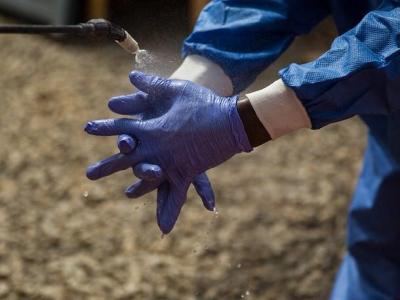April 8, 2005 (CIDRAP News) The only thing more unpredictable than the fickle, fast-changing influenza virus may be the US flu season itself.
Yet health experts who weathered this year's vaccine shortfall, which began early in October with the news that Chiron Corp. couldn't deliver nearly half of the expected US vaccine supply, have found the 2004-05 flu season instructive. The lessons they draw may prove helpful in managing future problems with supply and distribution and also in facing the possibility of pandemic influenza.
Expecting the unexpected
Flu vaccine can take a lot of detours between the egg and the arm. That's why flexibility is key, said Dr. Raymond Strikas, associate director for the adult immunization program at the National Immunization Program at the Centers for Disease Control and Prevention (CDC).
"Both influenza disease and vaccine supply are unpredictable," he told CIDRAP News. His list of lessons learned or reinforced this season highlights preparation: expect the unexpected, plan for many scenarios, be flexible, and be proactive.
"Partnership was a critical piece of what we did," Strikas said. "There needs to be coordination, particularly while the product is in short supply."
Health officials in Minnesota found the same thing, and are taking steps to formalize new relationships before the next flu season.
Web-based partnerships
Virtual vaccine distribution systems may be increasingly important to managing supply during a flu season. Think of it as a way for many people to communicate effectively about vaccine orders, manufacturers, and supplies even in the off-season.
In Minnesota, for instance, the Minnesota Department of Health (MDH) is launching an Internet-based data collection tool, said Kristen Ehresmann, RN, MPH, manager of the department's immunization, tuberculosis, and international health section. Local public health workers will be able to track vaccine orders by healthcare providers, such as hospitals and nursing homes, as well as by manufacturers. The information will be accessible online, so "we'll go into the season knowing where people ordered from and how many doses they're expecting," Ehresmann said.
Although some state and local public health departments reported instances when they physically held or transferred flu vaccine, simply knowing where the doses are is often more important than having them in hand, officials said.
In addition, the MDH is working to enhance communication among those involved in flu immunization, Ehresmann said. Her office is convening a statewide workgroup on flu that will allow state officials to consult directly with healthcare providers in groups that may be affected by changes in the disease or the vaccine supply. In addition, the department is encouraging creation of community coalitions.
Stearns County, about 70 miles northwest of the Twin Cities, did a fine job ensuring that people received vaccine through an effective local collaboration, said Ehresmann, adding that MDH is encouraging similar efforts throughout the state.
One aspect of such collaboration is clarifying legal and liability issues, said Ned Calonge, MD, MPH, chief medical officer for the Colorado Department of Public Health and Environment (CDPHE). Redistributing vaccine, for example, might go more smoothly if officials could clarify who pays whom and how, as well as what liability issues affect state law.
Shortage turns to surplus
Nearly half of the expected US flu vaccine supply disappeared last fall because of contamination problems at a Chiron Corp. plant in England. Eventually, the country obtained about 61 million doses of flu vaccine instead of the roughly 100 million doses expected earlier.
Despite the shortfall, good news was plentiful this flu season. It was only a moderate season, with illness peaking in mid-February, according to a CDC recap in this week's Morbidity and Mortality Weekly Report (MMWR). The season was milder for kids this year, with far lower hospitalization rates than in the previous season. And an estimated 17 million Americans refrained from getting a flu shot so that doses would go to high-risk people.
Targeting those at greater risk from the flu proved effective, with vaccination rates for the high-risk groups hewing closely to the levels of previous years despite the reduced vaccine supply, MMWR reported March 31.
In the end, the expected vaccine shortage turned into a surplus: 3 million doses, roughly the equivalent of the CDC stockpile, remains, Strikas said.
It's not clear how many leftover doses may be in the hands of individual providers or groups. Ehresmann estimated that the number is in the thousands. Doses are only good for one season because the combination of viral strains used in the vaccine is changed every year, so many of the remaining doses may go to waste.
"We were really cautiousand rightly soabout supply, but we have always had vaccine that goes unused," Ehresmann said. But the surplus suggests to her that MDH must "do the least restrictive limiting we can possibly do, so we don't end up wasting vaccine," she said.
Multiple suppliers wanted
Having two companiesChiron Corp. and Sanofi-Pasteur (formerly Aventis Pasteur)provide the bulk of the nation's flu vaccine doesn't leave much room for handling problems, experts said.
"We're hopeful that one, two, or maybe more companies will be interested in selling [flu vaccine] in the US," said Strikas. "Then, if one has a hiccup, one or more can step in."
Calonge, with Colorado, called the current system too risky. "It's a more fragile system than I would like to see," he said.
Anticipating the worst: pandemic flu
Last fall, Coloradoans conducted a mass vaccination clinic in a small area to measure the state's ability to meet a mass vaccination target. It turned out to be one of the bright spots in the season, according to Calonge. Volunteers and ham radio operators helped coordinate the vaccine transfer among many counties. A daunting target vaccination rate proved more achievable than officials expected.
"We came away convinced that if we needed to use that process for pandemic flu, we could meet the vaccine requirement," Calonge said.
See also:
CDC. Estimated influenza vaccination coverage among adults and childrenUnited States, September 1, 2004January 31, 2005. MMWR 2005 Apr 1;54(12):304-7 [Full text]
CDC. Update: Influenza activityUnited States, 2004-05 season, April 8, 2005. MMWR 2005 Apr 8:54(13): 328-331 [Full text]


















